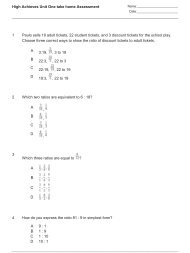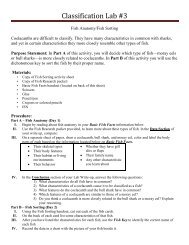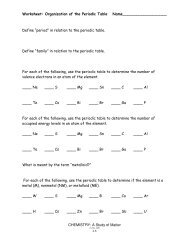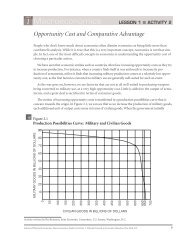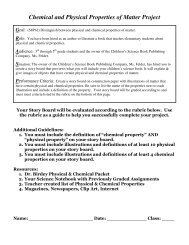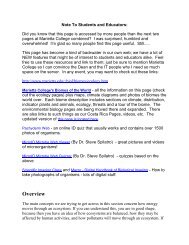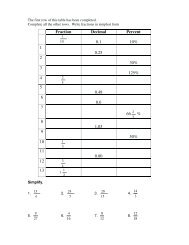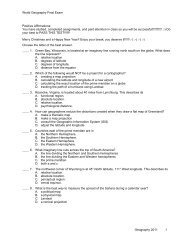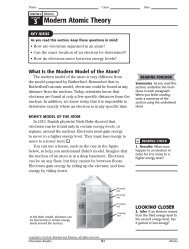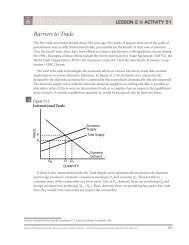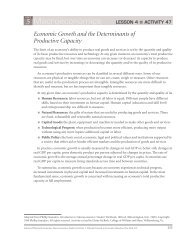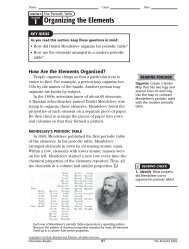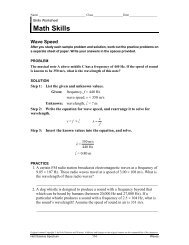World Languages Curriculum Map Level I.pdf - CommunityNet ...
World Languages Curriculum Map Level I.pdf - CommunityNet ...
World Languages Curriculum Map Level I.pdf - CommunityNet ...
- No tags were found...
You also want an ePaper? Increase the reach of your titles
YUMPU automatically turns print PDFs into web optimized ePapers that Google loves.
<strong>World</strong> <strong>Languages</strong> <strong>Curriculum</strong> <strong>Map</strong><strong>Level</strong> IDeKalb County Schools1
Table of Contents3 ---------------------- Introduction4 ---------------------- <strong>Level</strong> I Georgia Performance Standards5 ---------------------- Portfolio Instructions7 ---------------------- Unit #1: Classroom Survival Skills9 ---------------------- Unit #2: School11 --------------------- Unit #3: Self and Leisure Activities13 --------------------- Unit #4: Food and Restaurants15 --------------------- Unit #5: Clothing/ Shopping/ Stores17 --------------------- Unit #6: Family and Celebrations19 --------------------- Textbook Alignment with <strong>Curriculum</strong> <strong>Map</strong>- French (Bien Dit <strong>Level</strong> I)- Spanish (Avancemos <strong>Level</strong> I)2
Introduction to <strong>Curriculum</strong> <strong>Map</strong> for <strong>World</strong> <strong>Languages</strong>The curriculum map is based on Georgia Performance Standards for Modern <strong>Languages</strong> and ACTFL’sNational Standards for Modern <strong>Languages</strong>. This curriculum uses a thematic approach and was designed around theprinciples of Understanding by Design; planning with the end in mind. Each curriculum map is created to helpteachers create engaging and relevant communicative opportunities for students.These curriculum maps provide an outline for each thematic unit. Included in the maps are skeletonvocabulary and structure lists. Each classroom teacher has the opportunity to supplement these lists to meet theirown students’ needs. The curriculum maps represent the minimum of what must be taught in each thematic unit.Each teacher’s own additions of communicative classroom activities and Performance Based Assessments arecrucial for the success of this curriculum.Grammatical concepts are not specifically identified on these curriculum maps. Rather, this curriculumfocuses on communicative functions and themes allowing for implicit teaching of grammar rather than overtgrammatical lessons.Each curriculum map includes required student portfolio artifacts. Students will create portfolios with writtenand oral artifacts as evidence of their learning and language growth. These portfolios will accompany the studentsas they progress through different language levels. Please refer to the portfolio instructions for more information.Great care was taken in the development of this curriculum to ensure that current best practices and researchare reflected throughout. This curriculum is based on the state and national standards, not any specific textbook. Atextbook reference page has been created to aid teachers in correlating the textbook with the thematic units whenappropriate. Additional technology links and reading resources are listed on each map for teacher reference.3
Georgia Performance Standards- Modern <strong>Languages</strong>- <strong>Level</strong> IInterpersonal Mode of Communication (IP)MLI.IP1MLI.IP2The students exchange simple spoken and written information in the target language, utilizing cultural references where appropriate.The students demonstrate skills necessary to sustain brief oral and written exchanges in the target language.Interpretive Mode of Communication (INT)MLI.INT1MLI.INT2The students demonstrate understanding of simple spoken and written language presented through a variety of media in the targetlanguage and based on topics such as self, family, school, etc.The students interpret verbal and non-verbal cues to understand simple spoken and written messages in the target language.Presentational Mode of Communication (P)MLI.P1MLI.P2The students present information orally and in writing that contains a variety of vocabulary, phrases, and patterns.The students present brief, rehearsed material in the target language, such as dialogues, skits, poetry, and songs.Cultural Perspectives, Practices, and Products (CU)MLI.CU1 The students develop an awareness of perspectives, practices, and products of the cultures where the target language is spoken.Connections, Comparisons, and Communities (CCC)MLI.CCC1MLI.CCC2MLI.CCC3MLI.CCC4MLI.CCC5The students use information acquired in the study of the target language and information acquired in other subject areas to reinforceone another.The students demonstrate an understanding of the significance of culture through comparisons between the culture(s) studied andthe students’ own culture.The students compare basic elements of the target language to the English language.The students demonstrate an awareness of current events in the target culture(s).The students identify situations and resources in which target language skills and cultural knowledge may be applied beyond theclassroom setting, for recreational, educational, and occupational purposes.4
Portfolio Instructions <strong>Level</strong> IThe intent of the <strong>World</strong> Language portfolio is to track growth of proficiency during the students’ course of language study. . A portfoliothat contains audio and/ or video is extremely beneficial in that students have the opportunity to track their progress and reflect on theirgrowth during their study of language. The portfolio also provides concrete evidence of language learning for parents andadministration.Students will continue to add to the <strong>Level</strong> I portfolio during subsequent years. There are many options on how this portfolio may becreated and archived. Each Unit includes at least two portfolio entries, one oral and one written. A simple way to have students savethis information would be on the Share Drive at your school, or on their own First Class. Additionally, students could save theirdocuments and files on a Read/Write DVD or CD or even on a Flash Drive.Oral activities are intended to be video or audio recordings, using a video camera or a MP3 recorder. Microsoft office also allows forrecorded narration, which could be done with a microphone on a school computer. Below are the Required Portfolio entries for <strong>Level</strong> I.<strong>Level</strong> I Portfolio Requirements:This portfolio requires students to explore a target language country as they study each unit. Students will choose their country duringthe first unit and continue to study it throughout the course, culminating in a final presentation of the information researched throughoutthe course. One option to archive the work samples: Students may create a PowerPoint slide for each unit and record the oralinformation by adding narration with MP3 recording. The oral and written presentation will be in the target language.Additionally, each unit has an entry that allows students to describe themselves in a Video / Audio journal and build on what they havelearned.Unit 1: Classroom Survival SkillsCountry specific presentation: Choose a country to study throughout the semester/year. Spoken aspect requires you to state thename of the country and the language spoken there. (ex: My country is Mexico. Spanish is spoken in Mexico. Mi país es México. Sehabla Español en México.)Video/Audio Journal About Self: Introduce yourself and give any additional information that you know how to say in the targetlanguage.Unit 2: SchoolCountry specific presentation: Identify a major city and important landmarks in the chosen country.Video/Audio Journal About Self: Writing: Describe your school day. Tell what classes you have, the times of the classes, yourteachers, which classes you like and dislike, which classes are easy and difficult.5
Unit 3 Sports and Leisure activitiesCountry specific presentation: Identify a sports team or figure unique to your chosen country. Read a sports page in anewspaper/magazine (Identify cognates).Video/Audio Journal About Self: Describe to a friend how you like to spend your free time.Unit 4 Food and RestaurantsCountry specific presentation: Research an authentic recipe from a country and/or describe a typical meal in the country. Locate andresearch a restaurant in the target country and describe what you would order.Video/Audio Journal About Self: Describe all the components of your favorite meal. Next, give your opinion of the food from yourtarget language country. If you’ve never tried any, tell what you would like to try.Unit 5 Clothing/Shopping/StoresCountry specific presentation: Identify currency of chosen country. Convert currency to U.S. dollar and demonstrate how much aparticular item would cost in the country—is it cheaper or more expensive? Identify regional clothing and give your opinion about it.Video/Audio Journal About Self: Describe your favorite outfit or the outfit you are wearing. Compare it to an outfit you think is out offashion (provide a picture to show your audience as you describe it).Unit 6 Family and CelebrationsCountry specific presentation: Identify and describe celebrations of chosen country.Video/Audio Journal About Self: Describe the people that are most important to you. Tell about your family and friends, includingages, physical description, personality traits etc.Final Product / Presentations / Culminating entriesCountry specific presentation: Present a culminating product which includes all the chosen country’s information in single or mixedmedia.Video/Audio Journal About Self: Add an entry that allows you to include information about yourself that wasn’t previously included.6
<strong>World</strong> <strong>Languages</strong>- <strong>Curriculum</strong> <strong>Map</strong>- <strong>Level</strong> I- Unit #1- Classroom Survival SkillsUnit #1: Classroom Survival Skills 2 weeks (4 weeks 7 period day)Essential Question(s): How can I survive and thrive in a world language classroom?Unit Portfolio Projects:Country specific presentation: Student chooses a country to study throughout the semester/year. Spoken aspect requires studentsto state the name of the country and the language spoken there. (Ex: My country is Mexico. Spanish is spoken in Mexico. Mi país esMéxico. Se habla Español en México.)Video/Audio Journal About Self: Introduce yourself and give any additional information that you know how to say in the targetlanguage.Context(Be Able To)Vocabulary/Structures(to know)Culture/ Customs/ConnectionsTechnology/ Resources/ ReadingMLI.IP1AUse basic greetings, farewells,and expressions of courtesy.MLI.IP1HUse sequenced informationsuch as the alphabet, days ofthe week, months, seasons,and numbers in context.MLI.CCC3BIdentify basic sounddistinctions.Formal/InformalGreetings: Hello, How areyou?, I am well., I am notwell., Not bad., My nameis…, What is your name? ,Goodbye, See you later)Expressions ofcourtesy/emotion: Thankyou, you’re welcome, Niceto meet you.)AlphabetNumbers 0-31Calendar (Days, Months)Names and titlesCommon gesturesand non-verbal cuesConcept of timeClimate differencesComparative schoolcustoms/behaviorFormal / informaladdressGeographical areaswhere the languageAll <strong>Languages</strong>http://www.primaryresources.co.uk/mfl/mfl_french.htmhttp://www.episcopalacademy.org/htm/Units/Upper/modlang/putnam/general/resour.htmFL Internet Resources for Foreign <strong>Languages</strong>tudyGeneral Resourceswww.conjuguemos.comhttp://www.csun.edu/~hcedu013/eslsp.htmlVideos fromhttp://gpb.unitedstreaming.comwww.enchantedlearning.comwww.teachersdiscovery.comFrenchwww.uptoten.comGames, graphics, cartoons7
Context(Be Able To)MLI.CCC1CIdentify examples ofvocabulary, phrases, proverbs,and symbols from the targetlanguage that are used inother subjects.MLI.INT1C Understand simpleinstructions.MLI.INT2B Recognize basicnon-verbal cues.MLI.CCC3ARecognize cognates anddifferences in linguisticsystems.MLI.CCC1ADemonstrate knowledge ofgeographical locations.Vocabulary/Structures(to know)Introduction to telling time(even, half, quarter hour)Introduction to WeatherExpressions: cold, hot,rainy, sunnySounds/PronunciationDiacritical MarksClassroom Materials/School Vocabulary:book, pen, pencil, paper,notebook, binder,calculator, eraser, bookbag, cell phone, flash drive,desk, chair, computerClassroom Commands:Stand up, sit, listen, takeout, raise hand, turn, wait,open, close, enter, write,read, repeat, speak, work(in pairs), choose (apartner), be quiet, payattention, watch (TPR only)Culture/ Customs/Connectionsis spokenTechnology/ Resources/ Readingwww.cortland.edu/flteachList of foreign language linkswww.a-vous-la-france.co.uk/les_objets_de_la_classe.htmGermanhttp://dw-world.deGerman radio in 8 languageswww.studying-in-germany.deradiowww.deurschland.deOfficial Portal of the Federal RepublicJapanesehttp://www.mangolanguages.com/mainhttp://www.youtube.com/watch?v=f9jFUQ5vz08Spanishwww.studyspanish.comwww.spaineschange.com/es/sistema/educativowww.spainembedu.org/materialsCognates<strong>World</strong> <strong>Languages</strong>- <strong>Curriculum</strong> <strong>Map</strong>- <strong>Level</strong> I- Unit #1- Classroom Survival Skills (continued)8
<strong>World</strong> <strong>Languages</strong>- <strong>Curriculum</strong> <strong>Map</strong>- <strong>Level</strong> I- Unit #2- Self and SchoolUnit #2: School 2 weeks (4 weeks 7 period day)Essential Question(s): How might going to school in another country be different from going to a school in theUnited States?Unit Portfolio Projects:Country specific presentation: Identify a major city and important landmarks in the chosen country.Video/Audio Journal About Self: Writing: Describe your school day. Tell what classes you have, the times of the classes, yourteachers, which classes you like and dislike, which classes are easy and difficult.Context(Be Able To)Vocabulary/Structures(to know)RecycleCulture/Customs/ConnectionsTechnology/ Resources/ ReadingMLI.IP1BExpress likes, dislikes,preferences.MLI.CCC2B Demonstrateawareness of students’own cultures.MLI.IP1HUsed sequencedinformation such asalphabet, days of theweek, months, seasonsand numbers.Expressions of preference:to like, to dislike, to love, topreferSubjects:Math, Science, English,Social Studies, P.E.,Spanish, French, German,Latin, Japanese, Music,TechnologyCalendar: days, months,seasonsTime (including minutes,late and early)Numbers1-31ClassroomobjectsClassroomcommandsTime (full,half,quarter)Common gestures andnon-verbal cuesIdentify commonly heldviewpoints of thecultures, such as thoserelating to time,calendar, saints andeducationSystems of educationImportance ofBaccalaureate exam(when applicable)All <strong>Languages</strong>http://polyglot.lss.wisc.edu/lss/lang/span/span/spanban.htmlwww.puzzlemaker.comwww.rubistar.4teachers.orghttp://cyberschoolbus.un.org/index.htmlFrenchwww.utm.edu/department/french/french.htmlwww.bonjourdefrance.comwww.justlanded.com/englis/france/franceguice/Education/thelycee9
Context(Be Able To)Vocabulary/Structures(to know)RecycleCulture/Customs/ConnectionsTechnology/ Resources/ ReadingMLI.IP1EGive simple descriptions.MLI.IP2A Initiate,participate in, and close abrief exchange.MLI.P1APresent information froma variety of sources.MLI.CU1BIdentify commonly heldviewpoints of the cultures,such as those relating totime, education, andmeals.MLI.CCC1 Relate contentfrom other subjects.MLI.CCC5B Identifycommunity and Internetresources.Time Numbers (31-60)Ordinal numbers (1 st -10 th)Classroom activities:to begin, to end, to erase,to write, to finish, to eatlunch, to study, to teach, tolearn, to draw, to paint, toread, to write, to carry, togo, to arrive, to begin, toneed, (to be) (Students willrespond to verbalcommands. Students willproduce the “I” form ofthese verbs)Locations in the school:Classroom, cafeteria,office, gym , restroom, hall,media center, computer labDescriptive words: It is:fun, boring, difficult, easy,interesting, good, badTime zonesSeasonal differences inhemispheresClimateCountries and capitalsGermanwww.campus-germany.deDAAD scholarshipswww.germany-tourism.dewww.austria.info/uswww.myswitzerland.comofficial tourism web sitesGermany/Austria/SwitzerlandJapanesehttp://web.mit.edu/21f501/www/linkslangaugeSpanishwww.studyspanish.comwww.conjuguemos.comwww.spainexchange.com/es/sistema_educativowww.spainembedu.org/materials<strong>World</strong> <strong>Languages</strong>- <strong>Curriculum</strong> <strong>Map</strong>- <strong>Level</strong> I- Unit #2- Self and School (continued)10
<strong>World</strong> <strong>Languages</strong>- <strong>Curriculum</strong> <strong>Map</strong>- <strong>Level</strong> I- Unit #3- Leisure ActivitiesUnit #3: Self and Leisure Activities 3 weeks (6 weeks 7 period day)Essential Question(s): How is teen life in the United States different from teen life in another country?What do teens in America and teens in other countries like to do in their spare time and why?Unit Portfolio Projects:Country specific presentation: Identify a sports team or figure unique to chosen country. Read a sports page in anewspaper/magazine (Identify cognates).Video/Audio Journal About Self: Describe to a friend how you like to spend your free time.Context(Be Able To)Vocabulary/Structures(to know)RecycleCulture/ Customs/ConnectionsTechnology/ Resources/ ReadingMLI.IP1BExpress likes, dislikes,emotions, agreement, anddisagreement.MLI.IP1GAsk questions andprovide responses based onself and friends (1 st -3 rdperson singular).MLI.IP1H Use sequencedinformation meaningfully.MLI.IP2A Initiate, participatein, and close a briefexchange.Sports: soccer, baseball,football, tennis,volleyball, swimming,skiing, track, golf,basketball, wrestling,hockeyActivities: to play, to win,to lose, to dance, tosing, to read, to listen tomusic, to watch moviesand theater, parties,computer activities, totalk on the phone,television, video games,to ride bikes, to takewalks, to relax, to hangout,to have fun, toPreferences,dislikes,agreement,disagreement.ClassroomactivitiesTime/days of theweek /weather/seasonsGeography indiscussions ofactivitiesCommon gesturesandnon-verbal cuesCulture as it relatesto leisure activitiesin the target cultureas compared tothose in the UnitedStates.Identify countries inthe target languagethat participate invarious sports orleisure activities.Sports unique toAll <strong>Languages</strong>www.wordchamp.comNewspapers for all languages:www.teachersdiscovery.comSports reports clipsFrenchwww.justfrance.org/france/sports-in-franceGermanwww.perlentaucher.decultural informationwww.spiegel.deweekly news magazinewww.filmportal.decentral internet platform aboutGerman movies11
Context(Be Able To)Vocabulary/Structures(to know)RecycleCulture/ Customs/ConnectionsTechnology/ Resources/ ReadingMLI.INT1AIdentify main ideas andsome details when readingand listening.spend time (1 st -3 rdperson singular)Time (24 hour clock)ClassroomcommandsNumbers 0-60target countrieswww.german-way.com/sportSports in Germany, Austria,SwitzerlandMLI.P1APresent informationgathered from avariety of sources such asinformal conversations,interviews, readings, andmedia.MLI.CCC3A Recognizesimilarities/differencesbetween target languageand English.MLI.CCC4A Giveinformation regarding majorcurrent events of the targetlanguage.MLI.CCC4B Understand theimpact of current events oftarget cultures.Numbers (60 -100)Descriptive adjectives:smart, strong, weak,nice, mean, pretty, ugly,tall, short, dangerousAdverbs of frequency:never, often, from time totime, sometimes,always, rarelyBody parts: eyes, nose,mouth, ears, hands,head, arms, legs, feet,shoulders, knees, toesExpressions of health:“It’s good for you.” “It’sbad for you.”Japanesehttp://www.youtube.com/watch?v=f9jFUQ5vz08Spanishwww.espn.comMLI.CU1B Identifycommonly held culturalviewpoints.<strong>World</strong> <strong>Languages</strong>- <strong>Curriculum</strong> <strong>Map</strong>- <strong>Level</strong> I- Unit #3- Leisure Activities (continued)12
<strong>World</strong> <strong>Languages</strong>- <strong>Curriculum</strong> <strong>Map</strong>- <strong>Level</strong> I- Unit #4- Food and RestaurantsUnit #4: Food and Restaurants 3 weeks (6 weeks 7 period day)Essential Question(s): How do traditions concerning food, meals, and dining in the United States differ from those is anothercountry? What is it like to go into a restaurant in another country? What would I need to know to feel confident when I talk to thewaiter?Unit Portfolio Projects:Country specific presentation: Research an authentic recipe from a country and/or describe a typical meal in the country. Locate andresearch a restaurant in the target country and describe what you would order.Video/Audio Journal About Self: Describe all the components of your favorite meal. Next, give your opinion about the food from yourtarget language country. If you’ve never tried any, tell what you would like to try.Context(Be Able To)Vocabulary/Structures(to know)RecycleCulture/ Customs/ConnectionsTechnology/ Resources/ ReadingMLI.IP1CMake simple requests.MLI.IP2B Use formaland informal forms ofaddress.MLI.IP1DAsk for clarification.MLI.IP1GAsk questions andprovide responses.Order a meal: menu, waiter,reservations, pricing, bill, tips, Iwould like, Do you have? ,How much does it cost?, I amhungry, I am thirstyMeal vocabulary: breakfast,lunch, dinner, dessert, snack,to eat, to drink, to order, to askfor, to want, to be, to haveBasic food pyramid Meat:beef, pork, chicken, fish,Likes,dislikes,preferencesDescriptiveadjectivesActivitiesSeasons andactivitiesAdverbs offrequencyMeal customs andeating habitsRestaurant/caféetiquettePaying the billCommon food eaten intarget languagecountryCooking traditionsAgriculture andAll <strong>Languages</strong>www.mcdonalds.comMenus from around theworldFrenchwww.bistrodusommelier.comhttp://3suisses.frhttp://frac.comwww.carrefour.comhttp://gofrance.about.com/b/2009/05/26/france-for-foodies-grocery-shopping-and-themarket-experience-in-france.htmhttp://library.thinkquest.org/18783/food.html13
Context(Be Able To)Vocabulary/Structures(to know)RecycleCulture/ Customs/ConnectionsTechnology/ Resources/ ReadingMLI.IP1BExpress likes, dislikes,emotions, agreement,disagreement.MLI.P1BGive basicinformation about selfand others.MLI.IP1EGive simpledescriptions.MLI.CCC2ACompare culturalpatterns of behaviorand interaction.MLI.CCC2BDemonstrateawareness ofstudents’ owncultures.MLI.CU1ADemonstrateknowledge of culturalcontributions.Vegetables: lettuce, tomato,onion, potato, beans, corn,green beans, carrotsFruit: bananas, orange, apple,grapes, strawberries,pineapple, lemonGrains: bread, cereal, riceDairy: milk, cheese, eggs,yogurt, butterBeverages: water, soft drink,coffee, tea, iceFlavors: sweet, spicy, sour,saltyExpressions of courtesy:Thank you very much, mypleasure, you’re welcome, no,thank you, I would likeExpressing dissatisfaction:hot, cold, there is, there is notTalking about many people(we, you plural, they)Numbers1-100TimeCommandsindustryCommonly heldviewpoints of the targetculture, such as thoserelating to time andmeals.Compare and contrastcultural viewsregarding time andmeals with those in theUnited States.Germanwww.daskochrezept.de/communityinformation about cooking inGermanywww.knorr.derecipes and ideas for cookingJapanesehttp://japanese.about.com/bl_food.htmSpanishwww.Comidakraft.comhttp://www.mypyramid.gov/sp-index.htmlFood pyramid in Spanish includes articlesand basic descriptions; Downloadabledocuments for students to track food theyeat.Question words: what, who,where, when, why, how much,which14
<strong>World</strong> <strong>Languages</strong>- <strong>Curriculum</strong> <strong>Map</strong>- <strong>Level</strong> I- Unit #5- Clothing/Shopping/StoresUnit #5: Clothing/Shopping/Stores 3 weeks (6 weeks 7 period day)Essential Question(s): How do shopping and clothing customs in different countries differ from those in the United States? Is“fashionable” the same in all countries? What is the shopping experience in the target culture(s)?Unit Portfolio Projects:Country specific presentation: Identify currency of chosen country. Convert currency to U.S. dollar and demonstrate how much aparticular item would cost in the country—is it cheaper or more expensive. Identify regional clothing and give your opinion about it.Video/Audio Journal About Self: Describe your favorite outfit or the outfit you are wearing. Compare it to an outfit you think is out offashion (provide a picture to show your audience as you describe it).Context(Be Able To)MLI.IP1EGive simpledescriptions.MLI.IP1CMake simple requests.MLI.IP1DAsk for clarification.MLI.P1BGive basic informationabout self and others.MLI.INT1BComprehend simple,Vocabulary/Structures(to know)Colors: red, blue, green,yellow, brown, black, white,pink, purple, light, darkNumbers (1-1000)Clothing: shirt, pants, dress,skirt, jacket, sweater, shoes,socks, hat, jewelryDescribing clothing: ugly,pretty, long, short, expensive,cheapShopping: to go, to buy, towear, to choose, to pay, doRecyclePreferencesand dislikesExpressionsof courtesyNumbers 1-100To ask for, towant, toneed,AdjectivesCommandsCulture/ Customs/ConnectionsPricingCommonly heldviewpoints of the targetculture, specificallyabout shopping,clothingSizingCompare and contrastcultural viewsregarding clothing withthose views in theUnited States.Technology/ Resources/ ReadingAll <strong>Languages</strong>http://www.xe.com/ucc/Currency Converterwww.europeanunionfocus.comAll about the EUFrenchhttp://www.bbc.co.uk/languages/french/talk/shopping/http://www.digitaldialects.com/French/Clothes.htm15
Context(Be Able To)culturally authenticannouncements,messages, andadvertisements.MLI.CCC1BApply previouslylearned skills fromother subjects, whenappropriate, todemonstrateknowledge in thetarget language (e.g.using basic mathskills).MLI.IP1FComprehend basicdirections.Vocabulary/Structures(to know)you have? How much does itcost?)Idioms: To be fashionable etc.to fit, to look goodStores: grocery store, postoffice, department store,souvenir/gift shop, shoppingcenter, bankDirections: north, south, east,west, near, far, next to, to turn,to stop, to cross, right, left,straightRecycleCulture/ Customs/ConnectionsCurrency of targetcountriesTechnology/ Resources/ ReadingGermanhttp://www.bbc.co.uk/languages/german/lj/presents/www.ecb.int/stats/exchangeThe European Central Bank: Press,Events, PublicationsJapanesehttp://www.masteranylangauge.com/cgi/f/r/View.pl?pc=MALJapanese&tc=clothing&vm=fc&la=http://japanese.about.comhttp://shopping.yahoo.com/search/Spanishhttp://www.bbc.co.uk/languages/spanish/talk/ shopping/http://www.elearnspanishlanguage.com/vocabulary/clothing.htmlMLI.INT2ADifferentiate amongstatements, questions,and exclamations.www.elcorteingles.es/tiendasSpanish shopping siteMLI.P2B Demonstratecomprehension ofrehearsed material.<strong>World</strong> <strong>Languages</strong>- <strong>Curriculum</strong> <strong>Map</strong>- <strong>Level</strong> I- Unit #5- Clothing/Shopping/Stores (continued)16
<strong>World</strong> <strong>Languages</strong>- <strong>Curriculum</strong> <strong>Map</strong>- <strong>Level</strong> I- Unit #6- Family and CelebrationsUnit #6: Family and Celebrations 3 weeks (4 weeks 7 period day)Essential Question(s): How does family life in another country differ from family life in the United States? How are importantevents celebrated?Unit Portfolio Projects:Country specific presentation: Identify and describe celebrations of chosen country.Video/Audio Journal About Self: Describe the people that are most important to you. Tell about your family and friends, includingages, physical description, personality traits etc.Context(Be Able To)Vocabulary/Structures(to know)RecycleCulture/Customs/ConnectionsTechnology/ Resources/ReadingMLI.P1BGive basic information about selfand others including family activities.MLI.IP1GAsk questions and provideresponses based on topics such asself, family, holidays etc.MLI.P1APresent information gathered from avariety of sources such as informalconversations, interviews, reading,and media.Family: mother,father, brother,sister, uncle, aunt,cousin, grandfather,grandmother)Descriptiveadjectives: blond,dark, light, tall, short,brunette, beautiful,handsome, nice,intelligent, funny,red-head, seriousNumbers 0-100Expressions ofcourtesyPastimesDescriptiveadjectivesExpressions oflike, dislike,agreement,disagreement,preferences andopinionCulture specificcelebrationsBlended familyvocabularyCultural use oflast nameIdentify customs,behavior,commongestures andnon verbal cues,names and titlesand geographicalAll <strong>Languages</strong>http://tlc.howstuffworks.com/family/christmas-traditions-around-the-worldga5.htmwww.teacherdiscovery.comwww.wordchamp.comwww.quia.comwww.teachertube.comwww.quizlet.comwww.20q.net17
Context(Be Able To)Vocabulary/Structures(to know)RecycleCulture/Customs/ConnectionsTechnology/ Resources/ReadingMLI.P2ADemonstrate Novice-Mid proficiencyin pronunciation and intonation whenpresenting rehearsed material.MLI.CU1CDescribe customs and traditions ofthe culture such as greetings,celebrations, and courtesies.MLI.CCC2ACompare patterns of behavior andinteraction in the students’ ownculture with the target language.MLI.IP2C Demonstrate Novice-Midproficiency in oral and writtenexchanges.MLI.INT1D Demonstrate Novice-Midproficiency in listening, viewing andreading comprehension.MLI.P1C Demonstrate Novice-Midproficiency in oral and writtenpresentations.MLI.CCC5A Identify examples oftarget language and culture in mediaforms.Activities: to have, tobe, to live, tocelebrate, to havefun, to dance, tosing, to leave, tosay, to name or calloneself, to live (allforms))PossessiveadjectivesVocabulary:culturally specificcelebrationsPast tense isintroduced inpreviews for <strong>Level</strong> IIVerbs: to sit, towait, to open, toclose, to read, towrite, to speak, toenter, to choose,to eat, to drink, tocarry, to go, toarrive, to begin, tolove, to talk on thephone, to prefer, toname, to calloneselfThere is, there areIdiomaticexpressionsassociated withcelebrations in thetarget languageSome verbs offrequency, always,never, often, fromtime to time,sometimes, rarelyPastimes andleisure activitieslocations wherethe targetlanguage isspoken.Compare andcontrastAmericancultural viewsregardingcelebrations withthose of thetarget languageFrenchwww.uptoten.comwww.bonour.comwww.frenchtutorial.comwww.lsfrench.comwww.frenchchassistant.comwww.loquella.comwww.10best.comwww.casareal.comwww.discoverfrance.nt/France/DF-holidaysGermanwww.clubliste.defrom Hip Hop to Funk, fromTechno to Reggaewww.popkomm.deJapanesehttp://japanese.about.com/bl_family.htmhttp://jappaneselangaugeculturefood.com/japanese-culturecelebration-otoshidama.htmSpanishwww.studyspanish.comwww.conjuguemos.comwww.spainexchange.com<strong>World</strong> <strong>Languages</strong>- <strong>Curriculum</strong> <strong>Map</strong>- <strong>Level</strong> I- Unit #6- Family and Celebrations (continued)18
French- Bien Dit <strong>Level</strong> I- Textbook Alignment to <strong>Curriculum</strong> <strong>Map</strong>Unit #1 Classroom Survival Skills Chapter 1 : Salut, les copains ?Unit #2 SchoolUnit #3 Self/Leisure ActivitiesUnit #4 Food/ RestaurantsUnit #5 Clothes/Shopping/StoresUnit #6 Family and CelebrationsChapter 4 : Mon année scolaireChapter 2 : Qu’est-ce qui te plait?Chapter 5: Le temps libreChapter 6: Bon appétitChapter 7: On fait les magasinsChapter 9: Allons en ville!Chapter 3: Comment est ta famille?Chapter 8: À la maison19
Spanish- Avancemos <strong>Level</strong> I- Textbook Alignment to <strong>Curriculum</strong> <strong>Map</strong>Unit #1 Classroom Survival SkillsUnit #2 SchoolUnit #3 Self/Leisure ActivitiesUnit #4 Food/ RestaurantsUnit #5 Clothes/Shopping/StoresUnit #6 Family and CelebrationsLección PreliminarUnidad 2: Lección 1: Somos EstudiantesCalendar p. 165Unidad 2: Lección 1: Somos EstudiantesUnidad 2: Lección 2: En la escuelaOrdinal Numbers: p. 258Unidad 1: Lección 1: ¿Qué te gusta hacer?Unidad 1: Lección 2: Mis amigos y yoUnidad 6: Lección 1: ¿Cuál es tu deporte favorito?Health and Body Parts: p. 327Adverbs of Frequency: p. 87, 93Unidad 3: Lección 1: Mi Comida FavoritaFood Culture: p. 186, 187Unidad 4: Lección 2: ¿Qué hacemos esta noche?Unidad 4: Lección 2: ¿Qué hacemos esta noche?Colors p. 195Unidad 3: Lección 2: En mi familiaUnidad 1: Lección 2: Mis amigos y yoUnidad 5: Lección 2: Una fiesta en casa20
Culturally Specific Celebrations: C1-C2521



